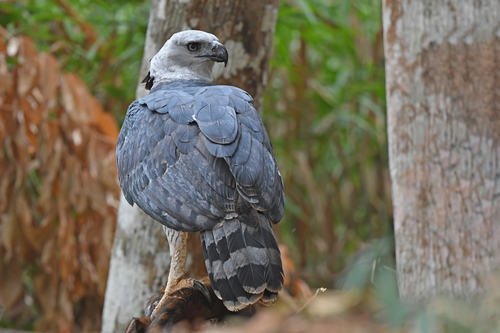
Harpy Eagle
The Harpy Eagle (Harpia harpyja) is one of the world's largest and most powerful eagles, renowned for its impressive size, formidable talons, and crucial role as an apex predator in Neotropical rainforests. It plays a vital part in maintaining the health of its ecosystem by regulating prey populations. Culturally, the Harpy Eagle holds significance in various indigenous communities, often symbolizing strength and power, and appearing in folklore and mythology.
86.5-107 cm
Length
176-224 cm
Wingspan
Near Threatened
Conservation Status
Distribution
The Harpy Eagle's range extends from southern Mexico through Central America and into South America, reaching as far south as northern Argentina. They are most commonly found in lowland tropical rainforests, but can inhabit areas up to 2,000 meters in elevation. Key areas include the Amazon Basin and the Pantanal.
Lifespan
Estimated 25-35 years in the wild.
Harpy Eagle's Habitat
Habitat Types
Lowland tropical rainforests, Subtropical forests, Occasionally, forest edges and fragmented areas
Climate Zones
Tropical, Subtropical
Adaptations
Their broad wings and relatively short tail enable exceptional maneuverability within dense forest canopies. Their powerful legs and enormous talons are adapted for capturing and carrying large prey.
Variations
While generally considered monotypic (no recognized subspecies), slight variations in size and plumage coloration may occur across their extensive range, but these are not formally classified.
Appearance
Breeding Plumage
Plumage is generally consistent throughout the year.
Seasonal Feather Changes
No significant seasonal variations.
Sex Based Plumage Differences
Males and females have similar plumage, characterized by a slate-black back, a white belly, and a gray head with a prominent double crest. The breast features a broad black band.
Notable Features
Large, prominent double crest on the head., Massive talons, larger than a grizzly bear's claws., Dark band across the chest., Broad wings and a relatively short, rounded tail.
Diet and Feeding
Primary Foods
Sloths, Monkeys, Other arboreal mammals (e.g., opossums, porcupines), Occasionally, large birds (e.g., macaws) and reptiles
Foraging Behavior
Harpy Eagles are primarily sit-and-wait predators. They perch on high vantage points within the forest canopy, using their keen eyesight to locate prey. Once prey is spotted, they launch powerful, swift attacks.
Specializations
Their exceptionally large and strong talons are specialized for grasping and killing large prey. Their legs and feet are incredibly powerful, allowing them to exert immense pressure.
Seasonal Diet Variations
Diet may vary slightly depending on prey availability in different seasons or regions, but they primarily remain focused on arboreal mammals.
Behavior
Social Structure
Harpy Eagles are generally solitary or found in pairs. They are not known to form flocks.
Communication
Vocalizations, including loud, piercing screams and whistles., Visual displays, such as raising their crest feathers., Mutual preening between pairs.
Migration
Harpy Eagles are non-migratory, remaining in their territories year-round.
Territorial or Group Behaviors
They are highly territorial, defending large home ranges that can encompass several square kilometers. Pairs actively patrol and defend their territories from intruders.
Conservation
Threats
Habitat loss and fragmentation due to deforestation (logging, agriculture, development)., Direct persecution (shooting) due to perceived threat to livestock or humans., Prey depletion due to hunting and habitat loss., Collisions with power lines.
Protection Programs
Protected areas and national parks within their range., Community-based conservation initiatives., Captive breeding and reintroduction programs in some areas., Research and monitoring programs to track populations and threats.
Local National Laws
Protected under national laws in many countries across their range. CITES Appendix I listing prohibits international trade.
Population Trend
Decreasing
Population Estimates
Fewer than 50,000 individuals estimated globally.
Interesting Facts
Their talons can exert several hundred pounds of pressure per square inch.
This immense pressure allows them to crush the bones of their prey instantly.
They are considered one of the most powerful raptors in the world.
Their size, strength, and hunting prowess place them at the top of the food chain in their rainforest habitat.
They have been known to take prey weighing up to their own body weight.
This demonstrates their incredible strength and lifting capacity.
The name "Harpy" comes from the harpies of Greek mythology.
These were fierce, winged creatures with the bodies of birds and the faces of women.
Faqs about Harpy Eagle
Are Harpy Eagles dangerous to humans?
While Harpy Eagles are powerful predators, attacks on humans are extremely rare. They generally avoid human contact.
What is the biggest threat to Harpy Eagles?
Habitat loss and fragmentation due to deforestation are the primary threats to their survival.
How can I help protect Harpy Eagles?
Support organizations working to conserve rainforest habitats, advocate for sustainable land use practices, and raise awareness about the importance of these magnificent birds.
Do Harpy Eagles mate for life?
Harpy eagles are believed to mate for life. They form strong pair bonds and maintain their territories together for many years.
Copyright @ Nature Style Limited. All Rights Reserved.
 English
English